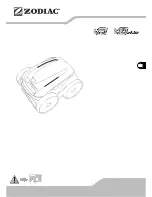
25
with the NFGC (U.S.) or B149 (Canada).
Vent pipes supported only by flashing and extended
above the roof more than 5’ (1.52 m) should be
securely guyed or braced to withstand snow and wind
loads.
The air inlet opening MUST be installed 1’ (0.3 m)
above the roof line or above normal snow levels that
might ob-struct combustion air flow. This dimension is
critical to the correct operation of the heater and vent-
ing system and reduces the chance of blockage from
snow. The vent cap must have a minimum 3’ (0.91 m)
vertical clearance from the air inlet opening.
Use only the special gas vent pipes listed for use with
Category IV gas burning heaters, such as the AL29-4C
stainless steel vents offered by Selkirk Inc. (1-800-
992-VENT or 1-800-992-8368 in the US, or 1-888-
SEL-KIRK or 1-888-735-5475 in Canada), Protech
System, Inc. (800-766-3473), Z-Flex (800-654-5600)
or American Metal Products (800-423-4270). Pipe
joints must be positively sealed. Follow the vent man-
ufacturer’s installation instructions carefully.
Outdoor Installation
A 5" (127 mm) length of 4" (101.6 mm) schedule 40
PVC pipe and a 4" (101.6 mm) schedule 40 PVC Tee
are provided for typical outdoor installations. If need-
ed additional vent (up to 65’ (19.81 m) equivalent) may
be added to locate the vent discharge away from the
appliance. When additional venting is supplied, the
vent must be supported and traps installed. In cold cli-
mates, it may be necessary to insulate the additional
venting..
Care must be taken when locating the heater out-
doors, because the flue gases discharged from the
vent cap can condense as they leave the cap.
Improper location can result in damage to adjacent
structures or building finish. For maximum efficiency
and safety, the precautions on page 25 must be
observed:
1. Periodically check venting system. The heater’s
venting areas must never be obstructed in any
way and minimum clearances must be observed
NOTE:
Condensate can freeze on the vent cap.
Frozen condensate on the vent cap can result in a
blocked flue condition.
NOTE:
Remove the unused gaskets from the 3 in 1
appliance vent adapter. For example, when using
the supplied PVC vent pipe remove the inner two
gaskets. See Figure 10.
electric meters, gas meters, regulators and relief
equipment. The distance of the vent terminal from
adjacent public walkways, adjacent buildings, open
windows and building openings must be consistent
Fig. 12: Direct Vent - Vertical
WARNING:
No substitutions of vent pipe or vent
cap material are allowed. Such substitutions would
jeopardize the safety and health of inhabitants.
Direct Vent—Vertical
Installation
These installations utilize the heater-mounted blower
to draw combustion air from outdoors and force the
heated flue products through the vent pipe under posi-
tive pressure. The vent material must be in accor-
dance with the above instructions for vent materials.
Vent material must be listed by a nationally recognized
test agency.
The connection from the appliance flue to the stack
must be as direct as possible and should be the same
size or larger than the vent outlet.
It is recommended that the intake vent be insulated in
colder climates.
Termination
The flue terminal should be vertical and should termi-
nate outside the building at least 2’ (0.61 m) above the
highest point of the roof within 10’ (3.05 m). The vent
cap should have a minimum clearance of 4’ (1.22 m)
horizontally from and in no case above or below
(unless a 4’ (1.22 m) horizontal distance is maintained)
Содержание X94
Страница 24: ...24 Fig 10 Outdoor Venting Fig 11 3 in 1 Multi Vent Adapter ...
Страница 32: ...32 WIRING DIAGRAM Fig 26 Wiring Diagram ...
Страница 33: ...33 SECTION 4 SERVICING INSTRUCTIONS GENERAL LOCATION OF CONTROLS Fig 27 Location of Controls ...
Страница 46: ...46 SECTION 6 REPLACEMENT PARTS ...
Страница 47: ...47 ...
Страница 52: ...www raypak com Raypak Inc 2151 Eastman Avenue Oxnard CA 93030 805 278 5300 Fax 805 278 5468 Litho in U S A ...
















































